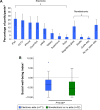Profound vision loss impairs psychological well-being in young and middle-aged individuals
- PMID: 28260855
- PMCID: PMC5328297
- DOI: 10.2147/OPTH.S113414
Profound vision loss impairs psychological well-being in young and middle-aged individuals
Abstract
Purpose: The aim of this study was to evaluate the effects of profound vision loss on psychological well-being in adolescents, young adults, and middle-aged adults with regard to mood, interpersonal interactions, and career-related goals. In addition, we assessed the significance of the resources that may be used to enhance psychological well-being in cases of profound vision loss, and in particular, examined the utility of low vision aids and the role of the ophthalmologist as a provider of emotional support.
Methods: A questionnaire was issued to individuals aged 13-65 years with profound vision loss resulting from Leber's hereditary optic neuropathy (LHON). Depression prevalence was evaluated with questions regarding major depressive disorder symptomatology. Participants appraised the effects of vision loss on their interpersonal interactions and career goals by providing an impact rating (IR) on a 21-point psychometric scale from -10 to +10. Social well-being index was defined as the average of interpersonal IR and career IR. Subjects were additionally asked about the use of low vision aids and sources of emotional support.
Results: A total of 103 participants (mean age =26.4±11.2 years at LHON diagnosis; mean ± standard deviation) completed the questionnaire. Nearly half (49.5%) met the depression criteria after vision loss. Negative impacts on interpersonal interactions (median IR = -5) and career goals (median IR = -6) were observed; both ratings were worse (P<0.001) for depressed versus nondepressed subjects. Older age at diagnosis corresponded to higher depression prevalence and increased incidence of negative interpersonal IR and career IR. Sixty-eight percent of subjects used electronic vision aids; controlling for age, social well-being index was higher among these individuals than for those who did not use electronic aids (P=0.03). Over half of the participants (52.4%) asserted that they derived emotional support from their ophthalmologist.
Conclusion: Profound vision loss in adolescents, young adults, and middle-aged adults is associated with significant negative psychological and psychosocial effects, which are influenced by age and use of electronic vision aids. Ophthalmologists, in addition to managing vision loss, may serve an important role in the emotional adaptation of these patients.
Keywords: Leber’s hereditary optic neuropathy; depression; low vision aids; psychological; quality of life; vision loss.
Conflict of interest statement
Disclosure The authors report no conflicts of interest in this work.
Figures




Comment in
-
Psychological morbidity in Leber's hereditary optic neuropathy depends on phenotypic, social, economic, and genetic factors.Clin Ophthalmol. 2017 May 22;11:959-962. doi: 10.2147/OPTH.S136761. eCollection 2017. Clin Ophthalmol. 2017. PMID: 28579746 Free PMC article. No abstract available.
Similar articles
-
Demographics of a Large International Population of Patients Affected by Leber's Hereditary Optic Neuropathy.Ophthalmology. 2020 May;127(5):679-688. doi: 10.1016/j.ophtha.2019.11.014. Epub 2019 Nov 25. Ophthalmology. 2020. PMID: 31932089
-
Male prevalence of acquired color vision defects in asymptomatic carriers of Leber's hereditary optic neuropathy.Invest Ophthalmol Vis Sci. 2007 May;48(5):2362-70. doi: 10.1167/iovs.06-0331. Invest Ophthalmol Vis Sci. 2007. PMID: 17460303
-
[Rapid onset of visual recovery following acute visual loss due to leber's hereditary optic neuropathy].Rev Neurol (Paris). 2005 May;161(5):599-601. doi: 10.1016/s0035-3787(05)85099-4. Rev Neurol (Paris). 2005. PMID: 16106816 French.
-
[The influence of mitochondrial haplogroup on Leber's hereditary optic neuropathy].Zhonghua Yi Xue Yi Chuan Xue Za Zhi. 2008 Feb;25(1):45-9. Zhonghua Yi Xue Yi Chuan Xue Za Zhi. 2008. PMID: 18247303 Review. Chinese.
-
Toxic medications in Leber's hereditary optic neuropathy.Mitochondrion. 2019 May;46:270-277. doi: 10.1016/j.mito.2018.07.007. Epub 2018 Aug 4. Mitochondrion. 2019. PMID: 30081212 Review.
Cited by
-
Psychometric Validity of the Visual Function Index in Leber Hereditary Optic Neuropathy.Transl Vis Sci Technol. 2023 Jan 3;12(1):23. doi: 10.1167/tvst.12.1.23. Transl Vis Sci Technol. 2023. PMID: 36662512 Free PMC article.
-
The Prevalence of Accommodative and Binocular Dysfunctions in Children with Reading Difficulties.Life (Basel). 2024 Dec 25;15(1):7. doi: 10.3390/life15010007. Life (Basel). 2024. PMID: 39859947 Free PMC article.
-
[Faricimab in previously treated neovascular age-related macular degeneration : Study design of the prospective noninterventional study PASSENGER].Ophthalmologie. 2025 May 21. doi: 10.1007/s00347-025-02258-y. Online ahead of print. Ophthalmologie. 2025. PMID: 40397174 German.
-
Capturing the experiences of patients with inherited optic neuropathies: a systematic review of patient-reported outcome measures (PROMs) and qualitative studies.Graefes Arch Clin Exp Ophthalmol. 2022 Jun;260(6):2045-2055. doi: 10.1007/s00417-021-05534-0. Epub 2022 Jan 13. Graefes Arch Clin Exp Ophthalmol. 2022. PMID: 35024911 Free PMC article.
-
Leber Hereditary Optic Neuropathy Gene Therapy: Longitudinal Relationships Among Visual Function and Anatomical Measures.Am J Ophthalmol. 2024 Jan;257:113-128. doi: 10.1016/j.ajo.2023.09.005. Epub 2023 Sep 15. Am J Ophthalmol. 2024. PMID: 37716450 Free PMC article. Clinical Trial.
References
-
- Nollett CL, Bray N, Bunce C, et al. High prevalence of untreated depression in patients accessing low-vision services. Ophthalmology. 2016;123(2):440–441. - PubMed
LinkOut - more resources
Full Text Sources
Other Literature Sources
Miscellaneous

